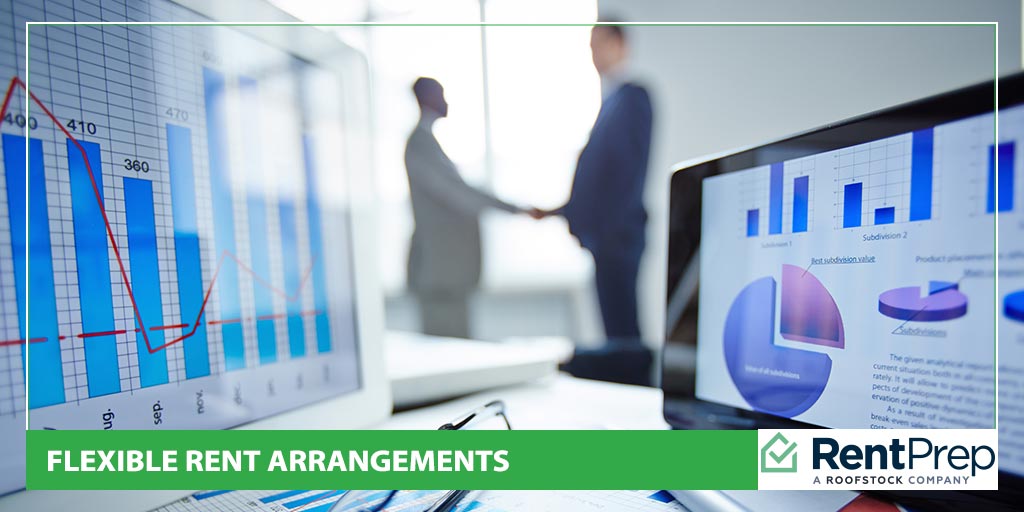
Landlords are often taught that you need to play by strict rules in order to keep your business alive. In most cases, this is very true. You need the rent to be turned in on time; you need evictions to be carried out when tenants break the lease. You need structure in order to be able to rely on your rental business.
Sometimes, however, landlords struggle with balancing empathy for the financial problems that a tenant is going through with the responsibility they have to their business. At times, you might be considering changing from the standard rent arrangement you have in place in order to continue working with a tenant.
Should you accept flexible rent arrangements as a working landlord? Is there a way to make this type of flexible arrangement work in a way that is good for your tenant and good for your business?
These are difficult questions to navigate, and there is no one-size-fits-all answer. Instead, you’ll need to build your response based on the situation of your tenants, your business, and your personal preferences.
A Table Of Contents For Flexible Rent Arrangements
- Consider The Situation
- Flexible Rent Agreement: Options
- Be Specific In All Agreements
- Case-By-Case Basis
- Remember: Communication Is Key
Consider The Situation

The first thing you will want to do is consider the situation of both you and your tenant in great detail. This consideration stage is important for deciding whether or not you can afford to make changes to how you collect rent and whether or not the situation your tenant is in warrants your empathy.
Making decisions so closely related to someone’s living conditions can be difficult, but it is part of your job as landlord to uphold the conditions of your lease. When you do decide to make exceptions, you need to be sure your business can handle the changes.
Mortgage
Should you accept flexible rent arrangements if you have to deal with mortgage payments?
Ask yourself a few questions about your current lending situation:
- Are you still paying a mortgage on the property in question or other properties that you manage?
- Does the rent from this property help cover the bills?
- Would you be able to make your mortgage payments on time if you do not get as much rent as usual for a few months?
- Are there any deferral options available from your lender that would apply to help in this situation?
Many landlords are still paying off their investment properties, and the rent from each property sometimes goes straight to each monthly payment. Landlords who have little excess cash flow will find it difficult to make their payments without rent. Consider where your business finances fall in this area.
Rainy Day Funds
Some landlords have set up a type of holding fund where they put some extra money for emergency situations. This might be used when a tenant doesn’t pay rent and you need to pay the mortgage before they catch up. Or, it might be used when a tenant moves out unexpectedly and you need to cover a few weeks of vacancy.
If you have enough in your rainy day fund to cover any temporary loss from a flexible rent arrangement, you can decide to use those funds to make the agreement work.
Business Expenses
In addition to your mortgage, you must take into consideration if you have any other business expenses that will greatly suffer from a flexible rent arrangement.
Do you keep any staff to help with your business? Do you pay regular contractors to help with work? Are you employing any type of rental management service or paying for online subscription services to support your business?
All of these expenses are part of the bigger picture that decides whether or not you can practically put any type of flexible rent arrangement into effect. Your profit margin will determine what type of plans you could consider to help your tenants, so keep that in mind.
Flexible Rent Agreement: Options
There are many different types of flexible rent agreements you can consider using. All of these arrangements are not one-size-fits-all deals; you need to analyze the specific situation to decide what arrangement will work best for your business.
Alternate Payment Plans

One of the most common types of flexible rent arrangement is a deferred payment plan or an alternate payment plan.
With these types of plans, tenants pay nothing or a reduced amount of rent for a set amount of time. Then, the amount of rent they didn’t pay is tacked onto their rental agreement in another way.
The unpaid rent might be divided out over a few months or it might be added on to the end of the lease to be paid when the tenant is moving out. There are many different ways that repayment can be arranged.
The specific repayment option should be decided based on what type of financial hardship your tenant is going through and when they can be expected to be able to pay rent normally again.
Examples
As mentioned, there are a lot of different ways this type of alternative arrangement can be set up. To help spark your imagination, here are a few examples:
- The tenant pays 30% of their rent due this month, and then the remainder is divided evenly over the next three rent payments in addition to their usual rent.
- The tenant pays nothing this month, but they need to pay double rent next month.
- The tenant pays 50% of their rent this month, and then the remainder is paid with next month’s rent.
- The tenant does not pay rent for 90 days, but the missed rent must either be divided throughout the rest of the rental period or paid when the lease expires.
Set Up Deferral Guidelines And Request Form
If you think a rent deferral plan could work for your business, creating a form that tenants can fill out will make it easier. You can give this form to tenants that come to you with concerns about being able to pay their rent. Having documentation will help you track the arrangement and get all the details you need.
Plus, you won’t need to think about what information you need from the tenant every single time you want to set up a deferral program; you can just reference the partial payment form!
Additionally, creating a criteria list for deferrals and how to use them can be created. Landlords can refer to this document to make decisions about deferrals in the future. Here is an example of the types of criteria.
Waive Late Rent Fees
Another way landlords can help their tenants get through difficult financial periods is to waive late rent fees. Depending on your rental agreement and your local guidelines, rent fees might be pretty expensive. They can cause a lot of extra stress for tenants already facing hardship.
If your tenant is only going to have a very temporary financial lapse, such as one month of late rent payment, you could consider waiving the late rent fee as a show of goodwill.
Additionally, landlords who set up a deferred payment plan typically waive late fees as the rent is no longer considered to be late once the new payment plan is set up.
Rearrange Collected Funds
Do you collect the last month’s rent for your properties in addition to the security deposit? If so, it might be possible to use the last month’s rent to pay for a missed month of rent. Then, the tenant would simply pay the last month’s rent before they move out.
In some areas, the security deposit may be able to be temporarily used to pay rent. Then, the tenant would need to repay the security deposit when they can. This would be much like a deferred payment plan, but it would be preferable to landlords who cannot easily cover a missed month of rent.
These methods are only useful when handling a single month of missed rent, and any use of a tenant’s security deposit should be done with great care. Security deposit and advance rental payment laws differ by state, and you must make sure you do not violate them even in a difficult situation.
Skip Payment Completely
If you are compelled to do so, and you can manage to do so financially, you can simply set up an arrangement where the tenant does not pay rent at all. Most landlords will not be able to handle this kind of financial arrangement, but there are some landlords who could fit this expense in their bottom line.
This isn’t an arrangement that should be considered lightly. However, if you believe this is the right thing to do, it is your decision. Just be sure that the decision is still made with your business’s future in mind.
Erase Move Out Penalties
If you cannot find a way to set up a flexible rent arrangement for your tenant, you can still help them in other ways.
Does your rental agreement include penalties if they decide to leave out early?
Waiving move-out fees or any other costs associated with breaking the lease can help your tenant to rearrange their financial situation without an added burden. Tenants who lost their income may need to move into a cheaper living situation; waiving late fees will help them do that with more dignity.
Be Specific In All Agreements
No matter what type of agreement you decide will work for you and your tenant, you need to make sure that you are very specific about the terms.
Everything needs to be clearly documented so all parties are on the same page and any potential legal issues can be avoided:
- Put the flexible arrangement into writing and have it signed by all involved parties.
- Update the lease agreement, as necessary, to include these changes.
- Keep records of all communications about the agreement.
- Document all rent payments as specifically as possible.
Keeping everything in writing protects both you and your tenant from future disagreements.
Case-By-Case Basis
All of these potential flexible rent arrangement solutions should be applied on a case-by-case basis. There is no way to set up one arrangement that will always work, so you should be prepared to mix-and-match solutions as needed.
Sometimes, you will need to deny a flexible rent arrangement request from a tenant. At other times, you may be willing and able to offer a tenant more than they were willing to hope for. You never know which situation you will be in until you examine the request and your finances.
Remember: Communication Is Key
No matter how you decide to proceed with flexible rent arrangements, you need to be sure your policies and decisions are clearly communicated to your tenant.
They should be familiar with all of the following:
- Baseline non-payment policies from the original lease
- Who to contact if they have trouble paying rent
- How their payment deferral will work
- What fees they will own and when
- Who to contact with any questions
As you work through these issues, you will want to balance your business policies with empathy. Sometimes, life gets hard no matter how well prepared a tenant is. At other times, you will not have it in your power to make any custom arrangements.
Be gracious but clear in your decisions. Clearly communicate everything with your tenants as you move forward, and you will be able to move through this tricky situation with as much grace as possible.

